P8 - Forces in Balance
1/53
Earn XP
Description and Tags
Name | Mastery | Learn | Test | Matching | Spaced |
|---|
No study sessions yet.
54 Terms
What is displacement?
Distance without change of direction.
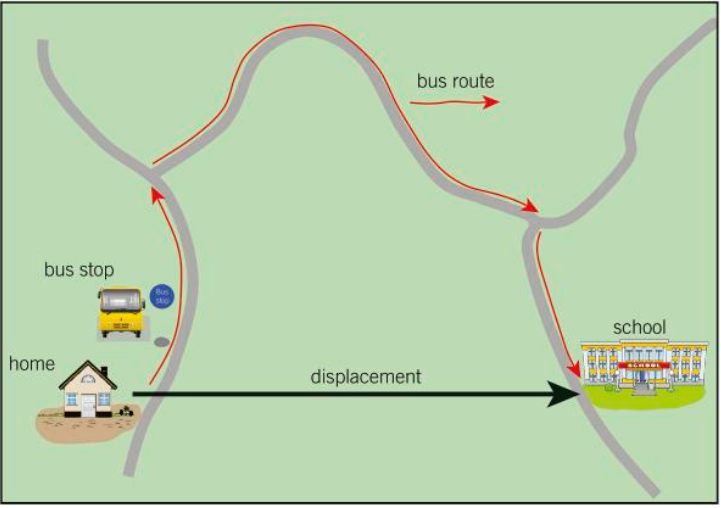
What are vectors?
Physical quantities that have direction.
Acceleration
Force
Momentum
Weight
A vector quantity has a magnitude and a direction.
E.g. - if the displacement of A to B is 5km due east, the magnitude is 5km and the direction is east.
What are scalars?
Physical quantities with no specific direction.
Speed
Distance
Time
Mass
A scalar quantity has a magnitude only.
What is a magnitude?
The size of a quantity.
How is a vector quantity represented?
The direction of the arrow shows the direction of the vector quantity.
The length of the arrow represents the magnitude of the vector quantity.

When are scale diagrams used?
When more than one force acts on an object.
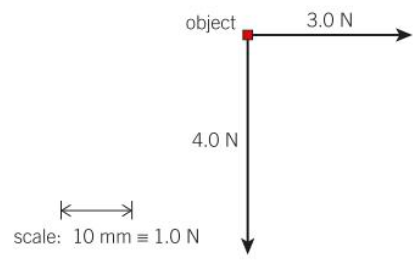
What is a force?
A push or pull that acts on an object because of its interaction with another object.
What is a contact force?
A force where two objects must touch each other to interact.
E.g:
Friction
Air Resistance
Stretching Forces (tension)
What are examples of Non-Contact Forces?
Magnetic Forces
Electrostatic Forces
The force of Gravity
What is Newton’s third law of motion?
Newton’s third law of motion states that when two objects interact with each other, they exert equal and opposite forces on each other.
E.g:
A boxer who punches a bag with a force of 100N experiences an equal and opposite force of 100N from the bag.
What is the driving force on a car?
The force that makes the car move. This is sometimes called the engine force or motive force.
What happens with friction when a car moves forward?
The force of the friction of the road on the tyre is in the forward direction.
The force of the friction of the tyre on the road is in the reverse direction.
These two forces and equal and opposite to each other.
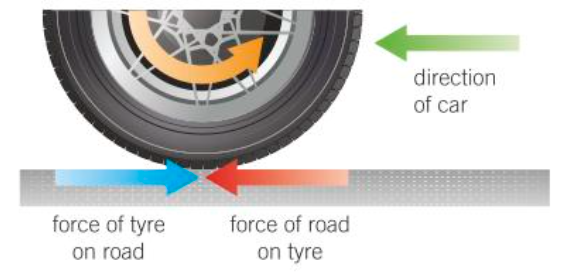
What is the resultant force?
A single force that has the same effect as all the forces acting on the object.
What is it called when the resultant force on an object is zero?
The forces acting on the object are balanced.
What is Newton’s first law of motion?
Newton’s first law states that if the forces acting on an object are balanced (the resultant force is 0), then:
If an object is at rest, it stays stationary.
If an object is moving, it keeps moving with the same speed and in the same direction.
What must be true if only two forces act on an object with zero resultant force?
The two forces must be equal to each other and opposite in direction.
What is it called when the resultant force on an object is not zero?
The forces acting on the object are not balanced.
What does the movement of an object depend on when it is not balanced?
The size and direction of the resultant force.
What must be true if an object is acted on by two unequal forces in opposite directions?
The resultant force is equal to the difference between the two forces.
The resultant force is in the direction of the larger force.

What are free-body force diagrams used to represent?
A free-body force diagram shows the forces acting on an object without any other objects or other forces shown. Each force is shown by a vector, which is an arrow pointing in the direction of the force.

How can the moment of the force (the effect of the force) be increased in an example with a spanner and a tight nut?
Increasing the size of the force
Using a spanner with a longer handle
What is the load?
The weight of the object.
What is the effort put on a crowbar?
The force a person applies on a crowbar.
What is a force multiplier?
Something which uses the same effort but moves a much bigger load.
What is the name of the line that a force acts along?
The force’s line of action.
What is the equation for the moment of a force?
Moment = Force x perpendicular
distance from
force’s line of
action to pivot
M = F x d
(Newton Metres, Nm) = (Newtons, N) x (Metres, m)
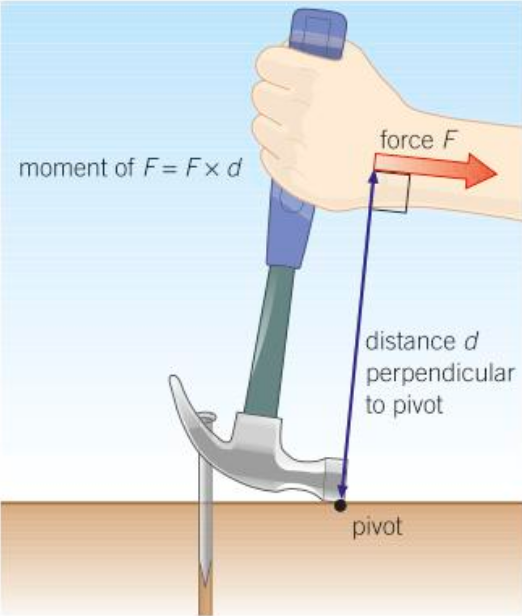
Why do we use levers?
To increase the size of a force acting on an object or to make the object turn more easily.
What must one do when using a lever to increase or multiply a force?
The force applied to the lever must act further from the pivot than the force it has to overcome.
Why is the force applied on a bottle opener much smaller than the force applied on the bottle top?
Because the line of action of the force you apply on the bottle opener is further from the pivot than the pivot is to the edge of the cap. This means that the bottle opener acts as a force multiplier and exerts a large force on the cap.
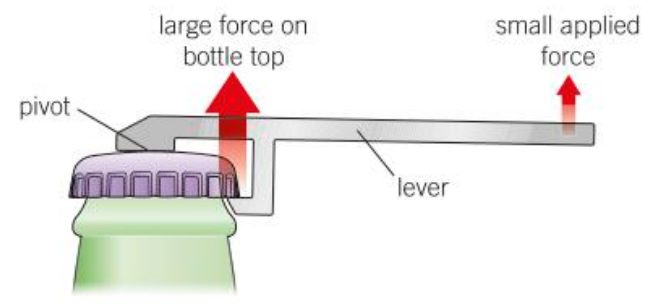
Why are gears like levers?
Because they can multiply the effect of a turning force.
E.g. When a car is in a low gear, a small gear wheel turns a larger gear wheel.
The gears multiply the turning effect of the engine force, so a bigger turning effect is exerted on the wheels when in a low gear.
When do gear wheels exert equal and opposite forces on each other?
Where their edges are in contact.
Why is the larger gear’s (wheel shaft) turning effect bigger than the turning effect of the smaller gear (engine shaft)
Because the gear wheels exert equal and opposite forces on each other where their edges are in contact. The force on each gear wheel acts tangentially at this point (at right angles to the line to the centre of the wheel). Since the turning force of the larger gear wheel acts further from its shaft than the turning force of the smaller gear, the turning effect of the larger gear wheel (the wheel shaft) is bigger than the turning effect of the smaller gear wheel (the engine shaft).

What happens when a low gear in a car is chosen?
A small gear wheel driven by the engine shaft is used to turn a large gear wheel on the output shaft. The output shaft turns slower than the engine shaft.
The turning effect of the output shaft is greater than the turning effect of the engine shaft. This is because the turning force of the larger gear acts further from its shaft than the smaller gear.
A low gear gives a low speed and a high turning effect.
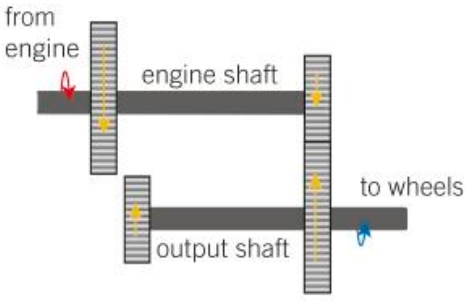
What happens when a higher gear in a car is chosen?
A large gear wheel driven by the engine shaft is used to turn a small gear wheel on the output shaft. So the output shaft turns faster than the engine shaft, so the car can move at a higher speed.
The force of the smaller gear wheel acts nearer to its shaft than the force of the larger gear wheel acting on its shaft. So the turning effect of the output shaft is less than the turning effect of the engine shaft.
A high gear gives a high speed and a low turning effect.
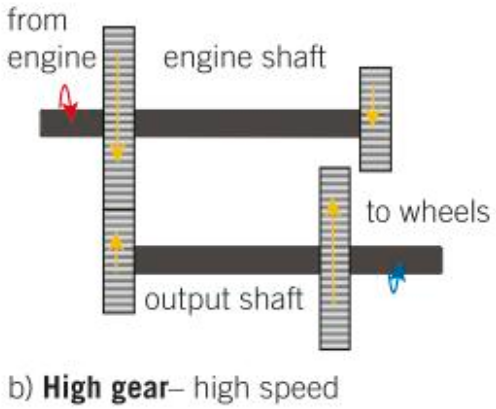
Why must a car’s centre of mass be as low as possible?
Because the car would overturn when going around corners at high speeds.
What is the centre of mass (centre of gravity) of an object?
The point at which an object’s mass can be thought of as being concentrated.
If you suspend an object and then release it, it will sooner or later come to rest with …
It will sooner or later come to rest with its centre of mass directly below the point of suspension. The object is then in equilibrium.
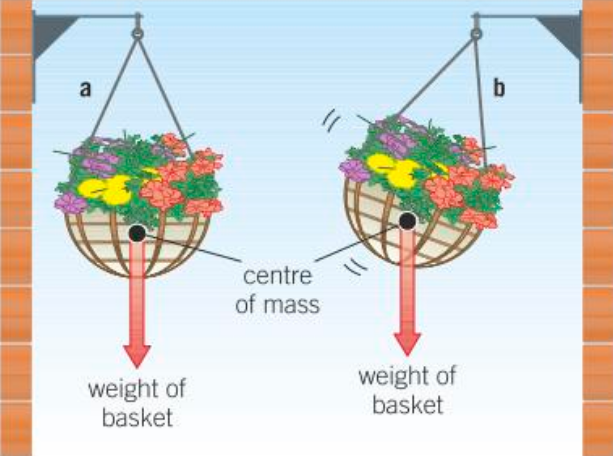
What does it mean if an object is in equilibrium?
The object is at rest.
Why does the weight of an object that is in equilibrium not exert a turning effect on the object?
Because its centre of mass is directly below the point of suspension.
What will happen if an object it turned from this position of equilibrium and then released?
The object will swing back to its equilibrium position.
This is because its weight has a turning effect that returns the object to equilibrium.
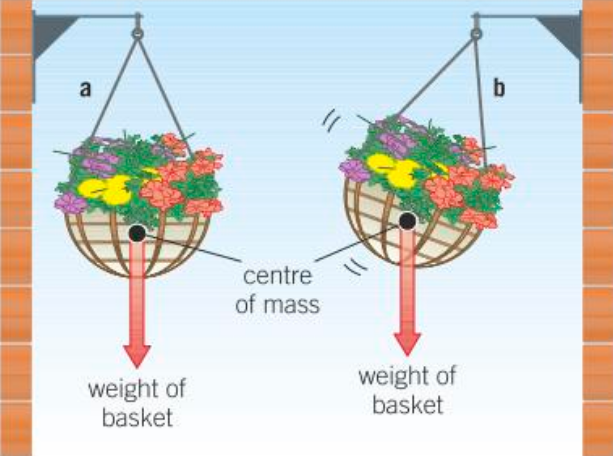
What can we say about an object if it returns to its equilibrium position after a turning force is taken away?
The object is freely suspended.
What is the centre of mass of a symmetrical object?
The centre of mass of a symmetrical object is along the axis of symmetry.
If the object has more than one axis of symmetry, its centre of mass is where the axes of symmetry meet.
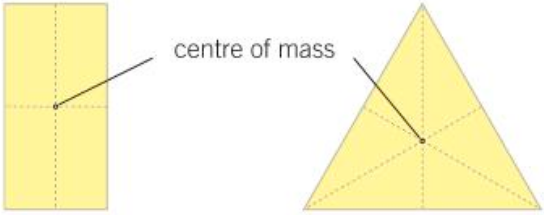
What is the equation for balanced anticlockwise and clockwise moments?
W₁d₁ = W₂d₂

What is the principle of moments?
For an object that is not turning:

What is the parallelogram of forces?
A geometrical method to find resultant force when two forces don’t act along the same line of action.
What angle must be the same as the angle between the two adjacent sides of the parallelogram of forces?
The angle between the two forces.
What does a parallelogram of forces look like?
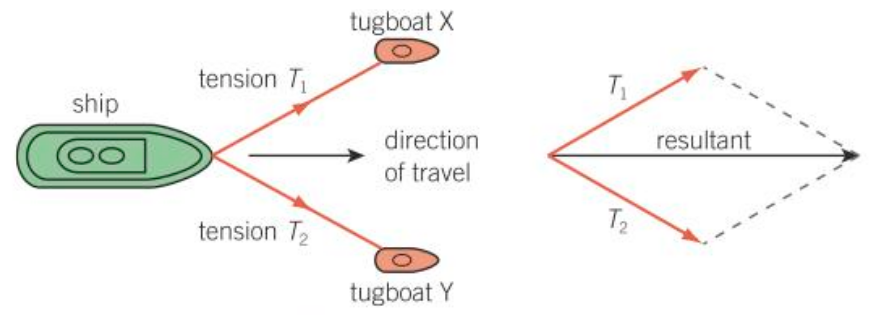
What is the resultant force in the parallelogram of forces?
The diagonal of the parallelogram from the origin of the two forces.
How does one demonstrate/investigate the parallelogram of forces?
One can use weights and pulleys to demonstrate the parallelogram of forces:
The tension in each string is equal to the weight it supports.
The point where the three strings meet is at rest.
The string supporting the middle weight is vertical.
You can measure the angles θ1 and θ2 with a protractor.
You can note the values of the three known weights.
You can then draw a scale diagram of a parallelogram so that:
The line down the centre of the diagram represents the vertical line through the point where the three strings meet.
Adjacent sides of the parallelogram at angles θ1 and θ2 to the vertical line represent the tensions in the strings supporting the weights.
The resultant force of the weights represented by the diagonal line should be equal and opposite in direction to the vector representing the middle weight.
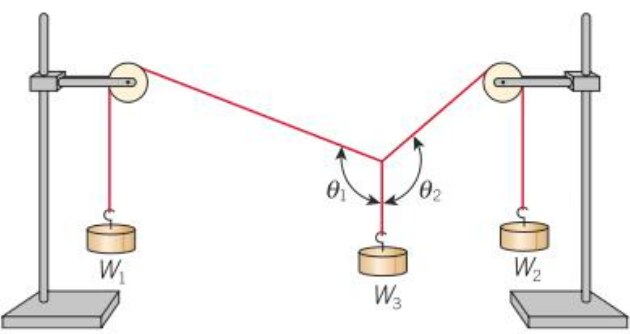
What is the resultant force on a parallelogram of forces?
The diagonal line from one end of the parallelogram to the other.
Measure it and use the scale accordingly.
Why is it more difficult to cycle uphill than to cycle on a flat road?
The weight of the cyclist and the bicycle have a downhill effect.
How does one resolve a force?
Resolving a force:
The weight of the box as a force vector is line OB
Think of the force vector as two parts or components. One force component acts down the slope (parallel) and one force component acts perpendicular to the slope.
The rectangle’s sides are parallel and perpendicular to the slope.
Side OA is the parallel component. The box is at rest on the slope and doesn’t slide down because of friction. The parallel component of weight acting down the slope is too weak to overcome the friction.
For a cyclist on an uphill road, the component of weight acting down the slope is the amount of force the cyclist has to match to keep moving up the hill.
Side OC gives the component of the weight acting perpendicular to the slope.
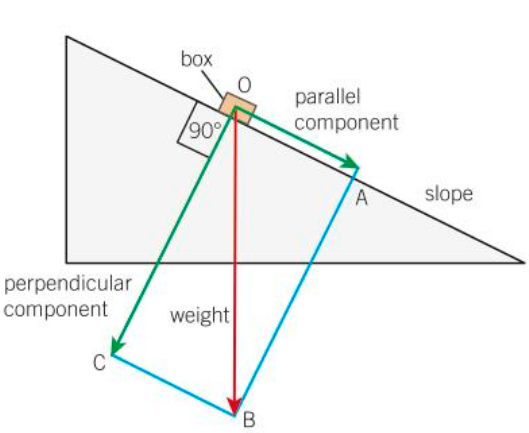
What are the key conditions for an object to be in equilibrium?
The resultant force is zero.
The forces acting on the object have no overall turning effect.
How do you workout whether or not an object is in equilibrium?
If the life of action of the forces are parallel, the sum of the forces in one direction must be equal to the sum of the forces in the opposite direction. Therefore, the resultant force on the object is zero.
If the lines of action of the forces are not all parallel, the force can be resolved into components along the same perpendicular lines. The components along each line must balance out if the resultant force is zero.